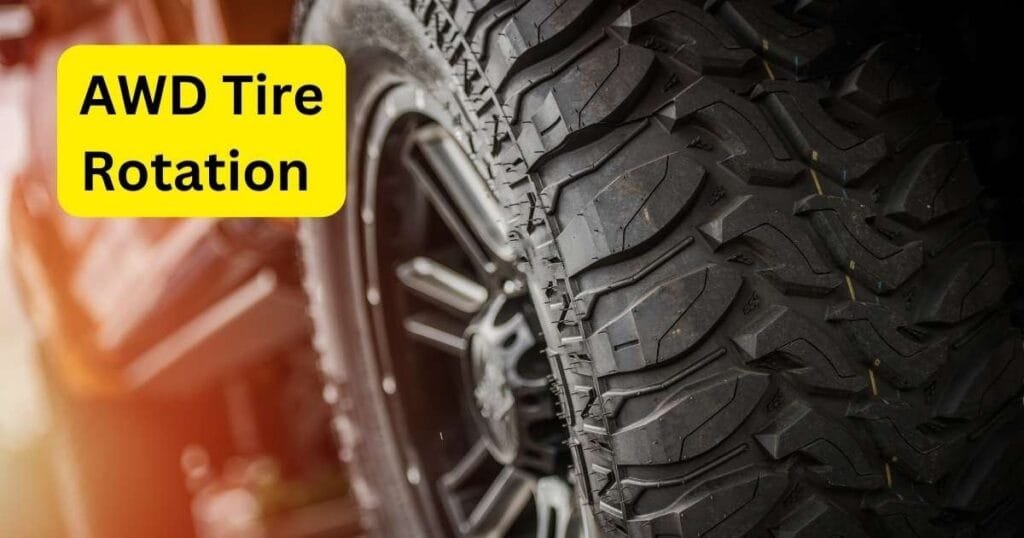Owning an All-Wheel Drive (AWD) vehicle offers superior stability and traction, especially in diverse weather conditions. Regular tire rotation is essential to maintain peak performance and extend tire lifespan.
AWD vehicles continuously distribute power to all four wheels, creating unique wear patterns requiring specific rotation strategies. This guide explores the importance of AWD tire rotation, optimal frequency, recommended rotation patterns, and maintenance tips.
By following these practices, you can ensure even wear across all tires, enhance handling, reduce noise, and safeguard your AWD system’s longevity and performance.
Table of Contents
How To Rotate AWD Tire?
AWD tires rotate diagonally: front left to rear right, front right to rear left, and rear right to front left. Due to the power distribution among all wheels, rotating tires on an AWD vehicle require careful attention.
To rotate effectively, follow a crisscross pattern: move the front tires straight back and the rear tires diagonally forward. This method helps maintain balanced wear for optimal performance.
Refer to your vehicle’s manual for recommended rotation patterns and frequencies tailored to your AWD system. Regular rotations ensure even tire wear, prolong the lifespan, and enhance overall driving safety.
Why AWD Vehicles Rotate Tires?
Many drivers assume that AWD negates the need for regular tire rotation. While AWD offers superior traction, it doesn’t cut uneven tire wear.
Factors like cornering, braking, and weight distribution can lead to uneven tire wear, making regular rotation essential for AWD vehicles.
Rotation promotes even tread wear. It improves handling, reduces road noise, and extends the life of the AWD system.
AWD (All-Wheel Drive) vehicles benefit more from tire rotations. The front-wheel drive (FWD) or rear-wheel drive (RWD) vehicles for a couple of reasons:
Uniform Wear
All four tires are constantly engaged in AWD cars, distributing power for traction and handling. This differs from FWD and RWD, where only the front or rear wheels power the vehicle because all four tires work equally in AWD.
They wear down at a similar pace to non-AWD vehicles. Regular rotations ensure each tire experiences different positions (front, back, etc.) to equalize wear and tear and maximize its lifespan.
Maintaining Drivetrain Health
AWD systems rely on the precise size and condition of all four tires. Significant differences in tread depth or tire size can stress the drivetrain.
Particularly the center differential, which distributes power between the front and rear axles. Rotations help prevent these imbalances and potential damage to the AWD system.
What are the effects of AWD and differentials on tires?
In a traditional two-wheel-drive system. Only the powered wheels experience wear. AWD engages all four wheels.
However, factors like cornering, braking, and weight distribution can disrupt even wear. Regular rotation addresses these challenges, promoting balanced tire wear.
AWD (All-Wheel Drive) and differentials can affect your tires positively and negatively.
Positive effects
AWD vehicles distribute power to all four wheels. Enhance grip on slippery surfaces like snow, mud, or gravel. This reduces tire wear caused by excessive slipping and struggling for traction.
Negative effects
Because all four tires are constantly engaged in AWD, they generally wear down faster than FWD or RWD vehicles where only two wheels power the car.
AWD systems rely on differentials to allow for slight differences in wheel speeds when cornering or turning. Mismatched tire sizes or uneven tread wear can put more stress on these differentials, leading to damage.
To counteract these adverse effects and maximize tire life in an AWD car:
Regular rotations (every 3,000-5,000 miles) are even more crucial for AWD vehicles to ensure even wear across all four tires when replacing tires.
Installing all four tires of the same size, brand, and tread pattern is important. This maintains a uniform diameter and prevents imbalances in the drivetrain.
Maintaining correct tire pressure as specified by the manufacturer is essential for all vehicles, especially for AWD cars. Improper inflation can cause uneven wear, reduce handling, and put extra strain on the drivetrain.
AWD offers superior traction. However, following proper tire maintenance practices like rotations, matching tires, and inflating them can lead to faster and even more tire wear.
You can maximize your tire lifespan and ensure optimal performance from your AWD system.
What Are the Benefits of Regular Tire Rotation for AWD Vehicles?
Regular rotation offers many benefits for AWD vehicles. It promotes even tread wear, improves handling, reduces road noise, and extends the life of the AWD system.
These advantages contribute to a safer and more enjoyable driving experience.
AWD engages all four tires for power and handling, leading to more even wear than front-wheel drive (FWD) or rear-wheel drive (RWD) vehicles.
Rotations ensure each tire spends time in different positions (front and rear) on the car. This evens out wear patterns and extends the lifespan of your tires.
Even tread depth across all four tires is crucial for predictable handling, especially in adverse weather conditions. Rotations help maintain this uniformity, allowing your car to corner, speed up, and stop.
AWD systems rely on all four tires being similar in size and condition. Uneven tread depth or mismatched tire sizes can put stress on the drivetrain.
The center differential handles distributing power between axles. Regular rotations help prevent these imbalances and safeguard your AWD system from potential damage.
In essence, regular tire rotations for AWD vehicles:
Promote even wear and tear, extending tire life.
Maintain consistent handling and braking performance.
Protect the AWD system from stress caused by uneven tire sizes.
How Often Should You Rotate Tires on an AWD Vehicle?
AWD vehicles need tire rotations every 3,000-5,000 miles, which is more frequent than the 5,000-7,500 miles recommended for FWD/RWD cars. Consult your owner’s manual for specific recommendations based on your vehicle and driving habits.
It’s recommended to rotate tires on an AWD (All-Wheel-Drive) vehicle more than on front-wheel drive (FWD) or rear-wheel drive (RWD) vehicles. Here’s a breakdown of the recommended frequency and why it’s important.
What is the Reason for Frequent Rotations?
All four tires are constantly engaged in AWD vehicles, distributing power for traction and handling. This even distribution leads to more uniform wear compared to non-AWD vehicles.
But it also means all four tires wear down faster. Regular rotations ensure each tire spends time in different positions (front and rear) on the car, equalizing wear and tear and maximizing lifespan.
If you drive in stop-and-go traffic, tow heavy loads, or navigate off-road terrains. You might need more frequent rotations to compensate for the increased wear.
Regardless of the mileage, visually inspect your tires for uneven wear patterns. If you notice any irregularities, have your tires rotated sooner rather than later.
What Are the Types of Tire Rotation Patterns for AWD Vehicles?
Front-to-Back Cross Rotation for non-directional tires and X-Pattern Rotation for directional tires. Consult your owner’s manual or a qualified technician for the appropriate pattern for your specific AWD vehicle and tire setup.
AWD vehicles follow the “front to back diagonal” rotation pattern. This involves moving the following:
· Front left tire to the rear right
· Front right to the rear left
· Rear right to the front left
· The rear left to the front right.

When to Rotate AWD Tires?
The frequency of AWD tire rotation depends on factors like the manufacturer’s recommendation. A good starting point is every 5,000 to 7,500 miles or every six months.
Adjust the interval based on your specific driving habits and conditions. AWD (All-Wheel Drive) vehicles need more frequent tire rotations than front-wheel drive (FWD) or rear-wheel drive (RWD) vehicles.
Why Frequent Rotations?
All four tires are constantly engaged in AWD vehicles, working together for traction and handling. This even distribution leads to more uniform wear compared to non-AWD vehicles.
But it also means all four tires wear down at a faster rate. Regular rotations ensure each tire spends time on the car in different positions (front and rear). This evens out wear patterns and maximizes the lifespan of your tires.
What Are the Extra Tips for AWD Tire Maintenance?
AWD vehicles need tire rotations every 3,000-5,000 miles. This is more frequent than the 5,000-7,500 miles recommended for FWD/RWD cars.
Apart from regular rotation, proper tire pressure maintenance and visual inspections are also needed. Aligning wheels and balancing tires contribute to optimal AWD tire performance.
Regular checks and prompt addressing of concerns ensure a safer driving experience.
Conclusion
Implementing a regular AWD tire rotation routine and following extra maintenance tips can ensure optimal performance, extended tire life, and a safer driving experience for yourself and your passengers. Consulting your owner’s manual and seeking professional help are crucial aspects of responsible AWD vehicle maintenance.
FAQs
Why is tire rotation important for AWD vehicles?
Regular tire rotation is essential for AWD vehicles to address uneven wear, which is caused by factors like cornering, braking, and weight distribution. It promotes even tread wear, improves handling, reduces road noise, and extends the life of the AWD system.
How often should I rotate the tires on my AWD vehicle?
The recommended frequency for AWD tire rotation is generally every 5,000 to 7,500 miles. However, adjusting the interval based on your driving habits and conditions is crucial.
Are there different rotation patterns for AWD tires?
Two primary rotation patterns exist for AWD vehicles: Front-to-Back Cross Rotation for non-directional tires and X-pattern rotation for directional tires.


